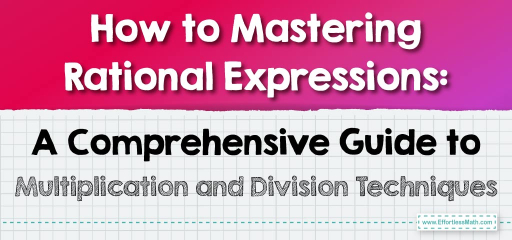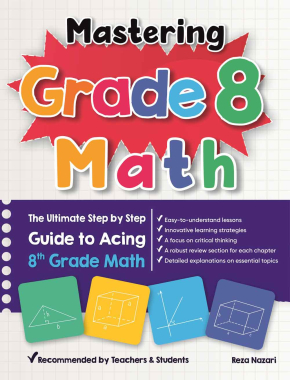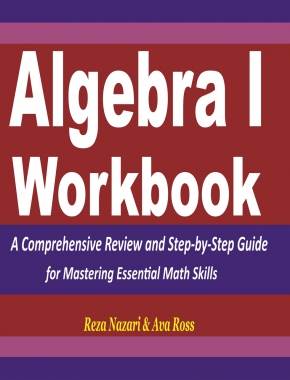How to Mastering Rational Expressions: A Comprehensive Guide to Multiplication and Division Techniques
Multiplying and dividing rational expressions involves several steps, similar to working with numerical fractions. A rational expression is a fraction where the numerator and the denominator are polynomials.

Step-by-step Guide to Master Multiplication and Division of Rational Expressions
Here’s a step-by-step guide to help you master the multiplication and division of rational expressions:
Multiplying Rational Expressions
Step 1: Factorize
- Factorize Numerators and Denominators: Begin by factorizing the polynomials in the numerators and the denominators of all the rational expressions involved. This step is crucial for simplifying the expression.
Step 2: Multiply
- Multiply Across: Multiply the numerators together and the denominators together. In other words, multiply numerator-to-numerator and denominator-to-denominator.
Step 3: Simplify
- Cancel Common Factors: Look for common factors in the numerator and the denominator and cancel them out. Remember, you can only cancel factors, not terms.
Step 4: Final Expression
- Write the Simplified Expression: Write down what remains after simplifying. If there are no common factors, then the expression is already in its simplest form.
Dividing Rational Expressions
Step 1: Factorize
- Factorize Numerators and Denominators: Similar to multiplication, start by factorizing the polynomials in the numerators and denominators.
Step 2: Reciprocal
- Take the Reciprocal of the Divisor: In division, take the reciprocal (flip) of the second rational expression (the divisor).
Step 3: Multiply
- Multiply as Before: Now multiply the first rational expression by the reciprocal of the second expression.
Step 4: Simplify
- Cancel Common Factors: Look for and cancel out any common factors in the numerator and the denominator.
Step 5: Final Expression
- Write the Simplified Expression: Record the simplified expression.
Final Word
Multiplying and dividing rational expressions require careful factorization and simplification. The key is to factorize completely, multiply (or take the reciprocal and then multiply in case of division), and then simplify by canceling common factors. With practice, this process becomes more intuitive.
Examples:
Example 1:
Multiply: \(\frac{x^2−4}{x+2}\) and \(\frac{x−1}{x^2−2x−8}\).
Solution:
- Step \(1\): Factorize
- \(\frac{(x+2)(x−2)}{x+2}\) and \(\frac{x−1}{(x+2)(x−4)}\)
- Step \(2\): Multiply Across
- \(\frac{(x+2)(x−2).(x−1)}{(x+2)⋅(x+2)(x−4)}\)
- Step \(3\): Simplify
- Cancel the common factors \((x+2)\).
- Step \(4\): Final Expression
- \(\frac{(x−2)(x−1)}{(x+2)(x−4)}\)
Example 2:
Divide: \(\frac{x^2−1}{x+1}\) by \(\frac{x^2−4}{x−2}\).
Solution:
- Step \(1\): Factorize
- \(\frac{(x+1)(x−1)}{x+1}\) and \(\frac{(x+2)(x−2)}{x−2}\)
- Step \(2\): Reciprocal
- Take the reciprocal of \(\frac{(x+2)(x−2)}{x−2}\), which is \(\frac{x−2}{(x+2)(x−2)}\).
- Step \(3\): Multiply
- \(\frac{(x+1)(x−1)}{x+1}⋅\frac{x−2}{(x+2)(x−2)}\)
- Step \(4\): Simplify
- Cancel the common factors.
- Step \(5\): Final Expression
- \(\frac{(x−1)}{(x+2)}\)
Related to This Article
More math articles
- How to Find Infinite Limits and Vertical Asymptotes?
- ISEE Middle-Level Math Worksheets: FREE & Printable
- Number Properties Puzzle – Challenge 16
- Top 10 Tips You MUST Know to Retake the SSAT Math
- Fundamental Theorem of Calculus: A Principle That Saves Your Life
- Overview of the ALEKS Mathematics Test
- Full-Length 8th Grade SBAC Math Practice Test
- Decimals Duel: How to Master the Art of Comparison
- Cracking the Code: How Math is Empowering Students to Solve Real-World Problems in the Digital Age
- SHSAT Math Practice Test Questions

















What people say about "How to Mastering Rational Expressions: A Comprehensive Guide to Multiplication and Division Techniques - Effortless Math: We Help Students Learn to LOVE Mathematics"?
No one replied yet.